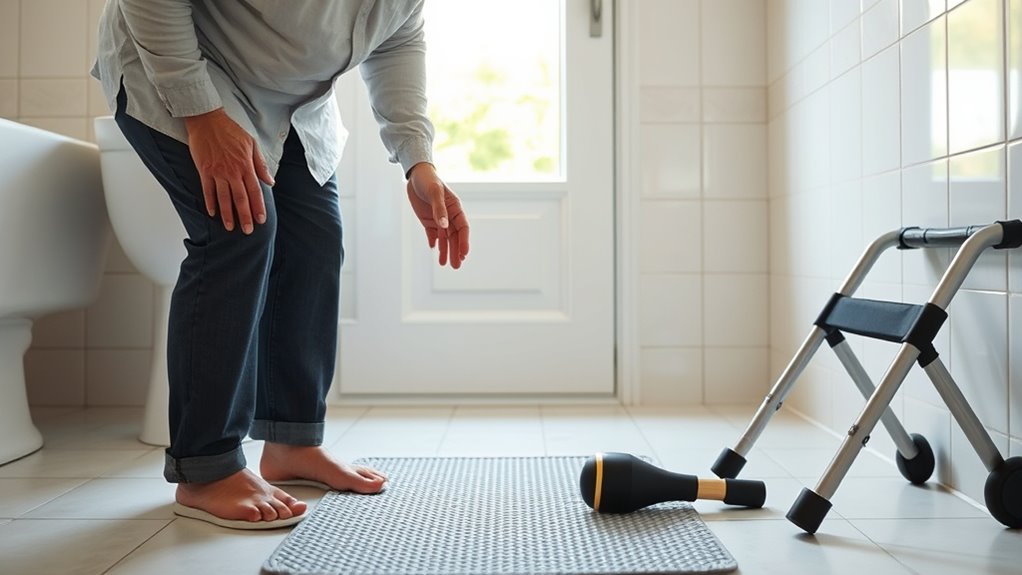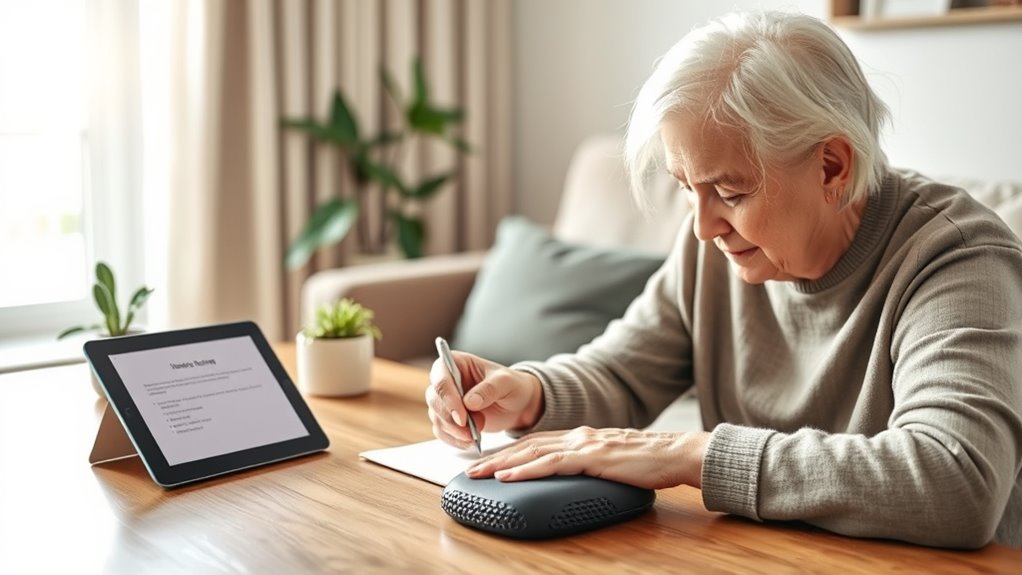Caring for someone with Parkinson’s disease involves managing movement challenges, preventing falls, and planning safe outings. Use cues, keep pathways clear, and wear supportive shoes to boost safety. Focus on proper nutrition and meal textures for swallowing difficulties. Prioritize your well-being by seeking support and setting boundaries. Prepare for emergencies and coordinate transportation carefully. If you want practical tips and resources to navigate these challenges confidently, there’s more to discover that can make caregiving easier.
Key Takeaways
- Develop personalized safety and mobility plans, including visual cues and clutter-free pathways, to prevent falls and freezing episodes.
- Schedule outings during medication “on” times and use supportive transportation options for safe travel.
- Prepare nutritious, easy-to-swallow meals with appropriate textures and hydration strategies to ensure safe eating.
- Prioritize caregiver self-care, seek emotional support, and use clear communication to manage caregiving stress effectively.
- Prepare for emergencies with accessible contacts, transportation plans, medication management, and safety tools.
Managing Daily Activities and Movement Challenges

Managing daily activities can be challenging for someone with Parkinson’s disease, especially as movement difficulties become more pronounced. You might notice changes in walking, like shuffling or trouble initiating movement, which can lead to freezing episodes.
To keep movement smooth, use simple cues such as “Big steps” to encourage automatic walking and improve gait. Assist with proper foot placement and suggest taking wide, deliberate steps to reduce the fall risk.
Avoid tight turns; instead, guide making wider, gradual turns to prevent freezing. Recognize that as the disease progresses, these movement issues may become more prominent.
Working with occupational or physical therapists can help develop personalized strategies to maintain mobility and safety, making daily activities more manageable.
Strategies for Preventing Freezing and Falls

To help prevent freezing episodes and falls, it’s essential to create a safe and supportive environment for the person with Parkinson’s. Keep pathways clear of clutter and obstacles to reduce triggers that can cause freezing or accidents during mobility.
Create a safe environment by keeping pathways clear to prevent freezing and falls.
Encourage wide, deliberate movements, especially when turning or *orchestrating through* narrow spaces, to decrease the risk of freezing. Visual cues, like floor markers or a laser pointer, can help initiate movement and prevent freezing episodes. Consider using an air purifier with HEPA filters to reduce allergens that may affect respiratory health during movement. Additionally, ensuring proper contrast ratio in lighting can improve visibility and enhance overall safety. Using mattress toppers can also provide additional comfort and support during rest, which is essential for maintaining overall mobility. Regularly engaging in exercises that improve balance and coordination can further enhance stability and prevent falls.
Make sure they wear well-fitted, supportive shoes with good traction to lessen slips and falls during freezing events.
Additionally, develop a fall safety plan that includes steps to call for help if a fall occurs, ensuring quick assistance and minimizing injury risk. Consider incorporating portable camping toilets to ensure accessibility and comfort during outdoor activities, enhancing their overall mobility experience.
Safety and proper mobility support are key.
Planning Safe Travel and Transportation Options

To guarantee safe travel, plan your outings around when your loved one’s medication works best to reduce symptoms. Additionally, ensuring that caregivers are aware of ethical hacking practices can help secure personal information during travel. Utilizing efficient general ledger coding can also assist caregivers in tracking travel expenses accurately and managing budgets effectively. Incorporating AI-driven solutions can further enhance travel safety by providing real-time updates on health conditions during outings. Understanding city dynamics is crucial for successful navigation in urban environments.
Choose transportation options with safety features, like trained drivers or accessible vehicles, to lower fall risks. Always prepare for emergencies by mapping accessible routes and carrying essential items like medications and emergency contacts. Additionally, consider using aesthetic solutions for organizing travel essentials to keep everything easily accessible and in order.
Schedule Around Medication Peaks
Scheduling activities during on periods helps reduce freezing and mobility issues, making outings safer and more comfortable. Allow extra travel time and include rest breaks to accommodate fluctuations in energy and motor function. Additionally, consider that some precious metals investments may provide financial stability, which can be beneficial for long-term care considerations. The presence of security systems in the home can also enhance safety, offering peace of mind during outings. Use reminders or alarms to ensure medication is taken on schedule, so travel plans coincide with peak symptom control. Communicating with healthcare providers can help identify the best timing for medication peaks, enabling you to incorporate this into your transportation planning effectively. Furthermore, consider incorporating a fun dessert into your outings as a treat, which can serve as a positive reinforcement for both you and your loved one. For instance, enjoying a scoop of gelato flavors like pistachio or seasonal fruit blends can be a delightful way to enhance the outing experience. It’s also important to ensure sunscreen protection is applied to avoid sunburn during outdoor activities, especially if you are planning longer outings.
Use Supportive Transportation Methods
Choosing the right transportation methods can considerably enhance safety and mobility for someone with Parkinson’s. Supportive transportation options, like specialized paratransit or ride-sharing with trained drivers, offer door-to-door assistance that simplifies travel. Engaging expert voice actors in audio materials can also help convey important travel information clearly. Additionally, utilizing a self-watering planter can reduce the burden of plant care at home, allowing caregivers to focus more on travel planning. Understanding reader expectations can help caregivers better communicate travel plans and needs. Regularly discussing glycolic acid benefits with healthcare professionals may also provide insights into skin care needs that could affect travel comfort.
As a caregiver, you should plan routes that avoid tight turns and crowded areas to reduce freezing episodes and fall risks. Schedule transportation during peak times for PD medications to ensure your loved one stays alert and mobile.
Always prepare for travel by carrying necessary medications, identification, and emergency contacts in case of delays. Discuss transportation options with healthcare providers or local Parkinson’s resources to identify safe, reliable methods. Additionally, consider incorporating music therapy techniques to help ease anxiety during travel.
Proper travel planning helps maintain independence while minimizing risks, ensuring smoother journeys for your loved one.
Prepare for Emergency Situations
Preparing for emergency situations is essential to guarantee your loved one can travel safely even when plans change unexpectedly. Develop a transportation plan that includes alternative options like taxis, rideshare services, or family members, so you’re ready if usual arrangements fall through.
Keep a list of emergency contacts, healthcare providers, and local transportation resources accessible at all times during travel. Additionally, having a plan in place for trick-or-treating practices can help ensure safety and organization during outings. It’s also wise to consider incorporating juice cleansing options into your routine, as it can provide a concentrated source of vitamins and antioxidants that support overall wellness during stressful times.
Pack essentials such as medications, medical information, and a list of current symptoms or recent changes to ensure quick access if needed.
Schedule travel around medication peaks and troughs to reduce mobility issues or freezing episodes.
Practice safe travel routines, like using handrails, taking frequent breaks, and ensuring assistance is available at transportation hubs.
Being prepared helps reduce stress and supports caregiving during unexpected emergency situations. Additionally, consider incorporating low light office plants in your travel accommodations to create a calming environment that can help alleviate stress.
Supporting Nutritional Needs During Mealtimes

To support your loved one’s nutritional needs during mealtimes, focus on adjusting food textures and ensuring safe swallowing. Serve soft, easy-to-chew foods and encourage small bites with frequent sips to prevent choking. Also, monitor hydration and avoid dry or tough foods that could increase the risk of aspiration. Incorporating advanced technology in meal preparation can also enhance the dining experience for those with special dietary needs. Understanding the impact of nutritional needs on overall health can also improve caregiving strategies.
Meal Texture Adjustments
Adjusting the texture of meals is essential for ensuring safe and enjoyable eating experiences for individuals with Parkinson’s disease. You can do this by focusing on meal textures that are soft, moist, and easy to chew, such as mashed potatoes, scrambled eggs, or yogurt.
These food modifications help manage swallowing difficulties and reduce choking risks. Avoid dry, tough, or crumbly foods like crackers or nuts, which can be unsafe.
Serve foods in small, manageable bites, and encourage slow eating to improve swallowing safety and digestion. During mealtimes, offering sips of liquids between bites can aid swallowing and hydration.
Hydration and Food Safety
Ensuring proper hydration and food safety during mealtimes helps support your loved one’s overall health and well-being. Focus on offering soft, easy-to-chew foods to minimize swallowing difficulties and reduce choking risks.
Encourage sipping liquids between bites to maintain hydration and make swallowing safer. Avoid tough, dry, or crumbly foods that could cause aspiration or lodge in the throat.
Adjust mealtime routines to accommodate slower eating, ensuring your loved one receives adequate nutrition without rushing. Regularly monitor hydration needs by offering fluids throughout the day, preventing dehydration.
Keep an eye on food safety by preparing food with the right textures and ensuring cleanliness. These steps help promote safe eating, proper nutrition, and better hydration, essential for managing Parkinson’s effectively.
Caring for Your Well-Being as a Care Partner

Caring for your well-being as a care partner is essential to sustain your ability to provide support. Prioritize self-care by scheduling regular breaks, engaging in exercise, and activities that promote relaxation to prevent caregiver burnout.
Seek emotional support through support groups, counseling, or connecting with friends, which helps manage stress and maintain mental health.
Setting realistic expectations and establishing boundaries ensures you don’t become overwhelmed, allowing you to balance caregiving duties with your personal needs.
Educate yourself about Parkinson’s disease to understand symptoms better and reduce frustration.
Utilize available resources like caregiver courses, helplines, and online communities to stay informed and supported.
Taking these steps keeps you resilient, so you can continue caring effectively without sacrificing your well-being.
Approaches to Caregiving for Patients With Dementia

When caring for patients with Parkinson’s disease and dementia, adopting tailored strategies is essential to address their unique cognitive challenges. Use clear, simple communication and visual cues to help reduce frustration and improve understanding.
Establish consistent routines and environmental cues to minimize disorientation and support independence. Prioritize safety by removing hazards and monitoring for wandering to prevent falls and injuries.
Keep the environment predictable to help patients feel secure and reduce confusion. Working closely with healthcare professionals can optimize medication management and behavioral strategies, ensuring your loved one’s needs are met effectively.
These caregiving strategies focus on safety, routines, and communication to improve quality of life for both you and the patient with dementia.
Essential Resources and Support Services for Caregivers

Finding the right resources and support services can make a significant difference in your caregiving journey. These tools help you stay informed, connected, and prepared to care for your loved one with Parkinson’s.
Accessing the right resources can empower you to care confidently for your loved one with Parkinson’s.
The Parkinson’s Foundation offers a Care Partner Guide, online articles, videos, and courses tailored to each stage of the disease.
The Helpline (1-800-4PD-INFO) provides personalized assistance and referrals for healthcare, legal, and emotional support services.
Additional resources like the PD Library and Expert Briefings keep you updated on research and caregiving strategies.
Support services such as online communities, support groups, and podcasts connect care partners and offer ongoing education.
These resources empower you to navigate caregiving with confidence and compassion.
Building Effective Communication With Your Loved One

Effective communication is key to maintaining a strong connection with your loved one as Parkinson’s progresses. Using face-to-face conversations and maintaining eye contact can help enhance understanding and foster trust. During advanced stages, simplify your approach by asking yes/no questions and repeating key points to guarantee clarity. Encourage your loved one to speak slowly or repeat words, which can improve comprehension. When verbal communication becomes difficult, spell out words or use visual aids to help convey your message. Respect their independence by involving them in daily decisions and activities whenever possible.
| Tip | Example |
|---|---|
| Use eye contact | Maintain eye contact during conversations |
| Simplify questions | Ask yes/no questions to help understanding |
| Repeat key points | Reinforce important information |
| Use visual aids | Pictures or written words to support communication |
Frequently Asked Questions
What Does a Caregiver Do for Someone With Parkinson’s Disease?
You assist with daily tasks like grooming, dressing, and meal prep to help your loved one stay independent.
You monitor their symptoms, manage medications, and coordinate appointments to keep their treatment on track.
You also offer emotional support, encouragement, and reassurance to ease psychological stress.
Additionally, you implement safety measures to prevent falls and injuries.
You advocate by communicating with healthcare providers, and organize care plans to ensure thorough support.
What Is the 5:2:1 Rule for Parkinson’s?
Imagine steering your diet toward a healthier horizon. The 5:2:1 rule guides you to keep saturated fats under 5 grams daily, enjoy only 2 servings of sweets or sugary drinks, and limit red meat to 1 serving.
What Are the Resources for Parkinson’s Patients?
You want to know about resources for Parkinson’s patients. The Parkinson’s Foundation offers a wealth of support, including a free PD Library with books, fact sheets, and educational materials.
You can access specialized kits like the Newly Diagnosed Kit and Aware in Care Hospital Safety Kit. Online courses, expert briefings, articles, videos, and the Helpline are also available to help you stay informed, manage symptoms, and get personalized assistance.
What Is the Caregiver Burden in Parkinson’s Disease?
You might feel overwhelmed by the caregiving burden, which includes physical, emotional, and financial stresses.
As the disease progresses, you face increasing demands, like helping with mobility, managing medications, and coping with unpredictable symptoms.
The emotional toll of witnessing your loved one’s decline can lead to burnout, frustration, and guilt.
Recognizing these challenges can help you seek support and find ways to manage your well-being.
Conclusion
By staying informed, staying patient, and staying connected, you can navigate the challenges of caregiving with confidence. Keep adapting your strategies, keep seeking support, and keep caring with compassion. Remember, your dedication makes a difference in your loved one’s life. Embrace the journey with resilience, embrace the moments with love, and embrace the hope for brighter days ahead. Together, you can face each day with strength and grace.









